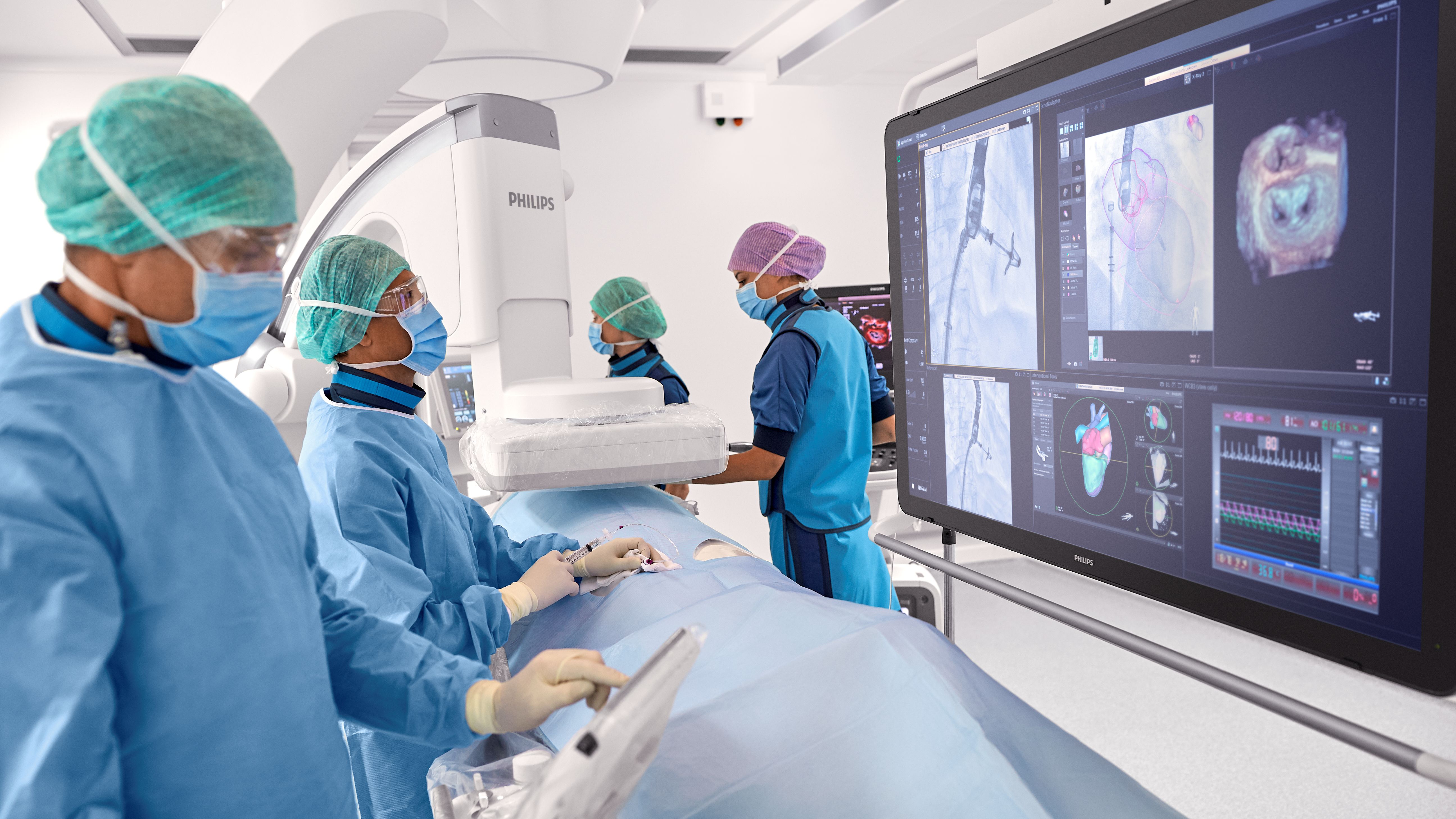
Image-guided therapy
ClarityIQ technology
Superb image quality and low X-ray dose
Our clinically proven ClarityIQ technology combines advanced, real-time image processing algorithms with state-of-the-art hardware. This unlocks superb visualization and significant dose reduction capabilities. ClarityIQ is available on Azurion systems.
Demonstrated results
Positively impact staff and patient experience
ClarityIQ technology touches every part of the Azurion imaging chain, from tube to display, to dramatically reduce X-ray dose. X-ray dose reductions of 65% and 67%, respectively, have been achieved in routine interventional neuroradiology and routine interventional cardiology.1,2

Powerful image processing technology
ClarityIQ Image processing works in real-time, enabled by the latest computing technology. It uses the following powerful image processing technology: Real-time Pixel shift (P) with Automatic Motion Control, Motion compensation (M), Noise reduction (N) and Image enhancement (I). Image processing enhances image quality without increasing patient dose. ClarityIQ image processing enables usage for any clinical domain and patient size.

Philips DoseWise: Personalized radiation management
Our dose management solutions specific to Philips interventional systems are known collectively as DoseWise; a unique combination of techniques, programs and practices, built into our image guided therapy systems that provide clinically relevant image quality during each interventional application, while managing dose.

Azurion 7 M20 with FlexArm - Unlimited imaging flexibility
Philips Azurion 7 with FlexArm provides unlimited imaging flexibility for diverse procedures and exceptional positioning freedom for medical teams. Its compact set-up provides a highly cost-effective environment. ClarityIQ technology, part of the Azurion system, enables excellent visibility at low X-ray dose levels for patients of all sizes.

1/3



Footnotes
- Buytaert, D., et al., Evaluation of patient and staff exposure with state of the art X-ray technology in cardiac catheterization: A randomized controlled trial. Journal of Interventional Cardiology, 2018. 31(6): p. 807-814. * Routine coronary interventions comprise of fluoroscopy and exposure usage. ** (95% CI of 53%, 77% for all diagnostic and interventional coronary procedures). The results of the application of dose reduction techniques will vary depending on the clinical task, patient size, anatomical location and clinical practice. The interventional cardiologist assisted by a physicist as necessary has to determine the appropriate settings for each specific clinical task. *** Results based on total dose area product from a single center prospective controlled randomized study (University Hospital Gent, Belgium) on 122 patients (42 for Allura Xper and 80 for AlluraClarity) undergoing coronary procedures. Of the 122 patients, 102 (83.6%) had a diagnostic procedure without intervention and 51 (41.8%) resulted in a diagnosis of no coronary disease. Patient radiation exposure was quantified using cumulative dose area product as collected from Radiation Dose Structured Reports and/or Allura Reports. Baseline dose was maintained by configuring both systems to power up with the lowest dose settings as default and default procedure settings for cardio were used. Exam duration and fluoro time was consistent between the systems and an increase in number of exposure images and runs with the AlluraClarity was attributed to the biplane configuration compared to the monoplane configuration of the Allura Xper.
- Söderman, M., et al., Radiation dose in neuro angiography using image noise reduction technology: a population study based on 614 patients. Neuroradiology, 2013. 55(11): p. 1365-1372. * Routine neuro interventions comprise of DSA and fluoroscopy usage. ** (95% CI 56%, 68% for routine diagnostic neuroendovascular procedures, 95% CI 58%, 71% for routine interventional neuroendovascular procedures). The results of the application of dose reduction techniques will vary depending on the clinical task, patient size, anatomical location and clinical practice. The interventional radiologist assisted by a physicist as necessary has to determine the appropriate settings for each specific clinical task. *** Results based on total dose area product from a single center retrospective historically controlled cohort study (Karolinska Hospital - Solna, Sweden) on 614 patients (302 for Allura Xper and 312 for AlluraClarity) undergoing neuroendovascular procedures.
Disclaimer
Results are specific to the institution where they were obtained and may not reflect the results achievable at other institutions. Results in other cases may vary.